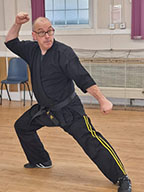The Syllabus
Karate for Children at EWRK Clubs
As it is felt that children cannot perform at the same level as an adult, Red Belts are given to children aged 11 and under. As they take grade examinations they will get coloured ribbons on their belts that match the adult equivalent. When they reach their 12th birthday they will be re assessed and issued the relevant full grade.
-
Beginners start with a plain white belt and then they are assessed from 9th Kyu through to 4th Kyu as "junior" grades, indicated by a red belt.
- Beginner - Red Belt
- 8th Kyu - Red Belt - Yellow Stripe
- 7th Kyu - Red Belt - Orange Stripe
- 6th Kyu - Red Belt - Green Stripe
- 5th Kyu - Red Belt - Blue Stripe
- 4th Kyu - Red Belt - Purple Stripe
- 3rd Kyu - Brown Belt
- 2nd Kyu - Brown Belt
- 1st Kyu - Brown Belt
- Shodan - Black Belt 1st Dan
There are no junior Brown Belts. By the time a child has reached this level of karate expertise they are graded the same as adults.
 Part of martial arts training is to have an ongoing set of achievable goals.
Part of martial arts training is to have an ongoing set of achievable goals.
The goal of achieving a black belt may seem very distant and almost unobtainable when you first start, however, learning a select few techniques and a kata (pattern of movements) is attainable in a relatively short time and within the grasp of anyone.
Each coloured belt is another small and attainable step towards your black belt. Beginners (not yet taken a grading examination) start with a white belt, symbolising purity and innocence.
Grading examinations are held approximately every three months and those who are ready are required to perform a set number of prescribed techniques - kicks, punches, strikes, defences and kata (patterns of movement). A panel of experienced black belts will check that the techniques are performed correctly to the required standard and then promote the student to a higher grade (if they are good enough!)
There are a total of 13 traditional Wado Ryu kata in the syllabus, mastery of which will take you from beginner to black belt and beyond.
In order they are:- Pinan Shodan, Pinan Nidan, Pinan Sandan, Pinan Yondan, Pinan Godan, Ku Shanku, Naifanchi, Chinto, Seishan, Wanshu, Bassai, Jion, and Rohai.
-
The belt order for students aged 12 and over is as follows...
- 8th Kyu - Yellow Belt
- 7th Kyu - Orange Belt
- 6th Kyu - Green Belt
- 5th Kyu - Blue Belt
- 4th Kyu - Purple Belt
- 3rd Kyu - Brown Belt
- 2nd Kyu - Brown Belt
- 1st Kyu - Brown Belt The next belt is Shodan - Black Belt 1st Level - for many, the ultimate goal of karate.
Constant, ongoing training is a necessary requirement for the Black Belt status to have meaning, and to prepare you for further, higher grading awards.
After a few years as a Shodan, one becomes eligible to take Nidan (2nd Level/Dan), and then (again, after a few years as a Nidan) the Sandan (3rd Level/Dan) examination looms! And so on, rising through the Dan Grades.
It is a common practice to place small "stripes" on the end of your black belt to indicate your grade - a stripe for each Dan awarded.
The times between black belt grades increase the higher a level you achieve, and Yudan (10th Level/Dan) is the highest attainable grade ... though this is extremely rare and represents a lifetime of dedication to your art.
CLICK HERE FOR THE BLACK BELT SYLLABUS
